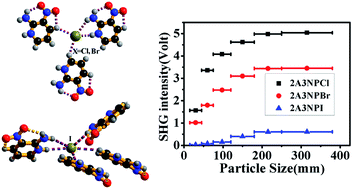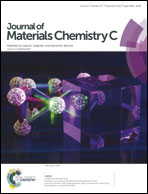Strong enhancement of second harmonic generation in nonlinear optical crystals: 2-amino-3-nitropyridinium halides (Cl, Br, I)†
Abstract
Three nonlinear optical (NLO) crystals of 2-amino-3-nitropyridinium halides (Cl, Br, I), which are assembled by anchoring the organic NLO chromophores into the halide anion frameworks through multicenter hydrogen bonds, have been successfully grown. Their optical transmittance window and cut-off wavelength have been investigated by UV-visible-NIR studies. The Kurtz–Perry powder measurements disclose a large enhancement of their NLO activities, i.e., second harmonic generation (SHG) efficiencies of 2-amino-3-nitropyridinium iodide are 1.5 times that of KDP, while the corresponding values for the compounds of 2-amino-3-nitropyridinium chloride and 2-amino-3-nitropyridinium bromide are about 15 and 10 times, respectively. Further structure analyses and theoretical calculations reveal that such a distinct difference in the NLO behaviours results from their diverse coplanar alignments and dipole-dipole superposition, which is expected to originate from the discrepant size of halide anions. It is believed that the enhancement of the NLO response would indicate a potential pathway to design new functional materials in the family of organic chromophores.


 Please wait while we load your content...
Please wait while we load your content...